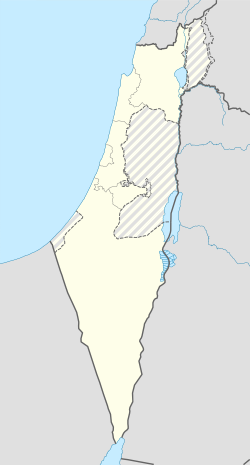
Adullam is an ancient ruin once numbered among the thirty-six cities of Canaan whose kings "Joshua and the children of Israel smote" (Joshua 12:7–24). After that, it fell as an inheritance to the tribe of Judah and was included in the northern division of the Shephelah "lowland" cities of the land of Judah (Joshua 15:35).

Suruh, was a Palestinian Arab hamlet, located 28.5 kilometers (17.7 mi) northeast of Acre. It became depopulated in the 1948 Arab-Israeli war.
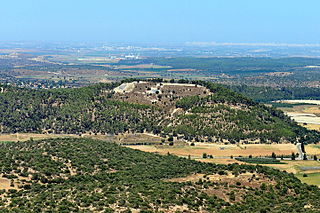
Azekah was an ancient town in the Shephela guarding the upper reaches of the Valley of Elah, about 26 km (16 mi) northwest of Hebron.

Zanoah is a moshav in central Israel. Located adjacent to Beit Shemesh, it falls under the jurisdiction of Mateh Yehuda Regional Council. In 2022 it had a population of 530.

Maresha was an Iron Age city mentioned in the Hebrew Bible, whose remains have been excavated at Tell Sandahanna, an archaeological mound or 'tell' renamed after its identification to Tel Maresha. The ancient Judahite city became Idumaean after the fall of Judah in 586 BCE, and after Alexander's conquest of the region in 332 BCE became Hellenised under the name Marisa or Marissa. The tell is situated in Israel's Shephelah region, i.e. in the foothills of the Judaean Mountains, about 1.5 kilometres (0.93 mi) south of Beit Gubrin.

Keilah was a city in the lowlands of the Kingdom of Judah. It is now a ruin known as Khirbet Qeyla near the modern village of Qila, Hebron, 7 miles (11 km) east of Bayt Jibrin and about 3 kilometres (1.9 mi) west of Kharas.

al-Karmil is a Palestinian village located twelve kilometers south of Hebron. The village is in the Hebron Governorate Southern West Bank, within Area A under total Palestinian control. According to the Palestinian Central Bureau of Statistics, the village had a population of 9,740 in 2017. The primary health care facilities for the village are designated by the Ministry of Health as level 2.

Sallama is a Bedouin village in northern Israel. Located in the Galilee near the Tzalmon Stream, it falls under the jurisdiction of Misgav Regional Council. In 2022 its population was 3,552. The village was recognized by the state in 1976.
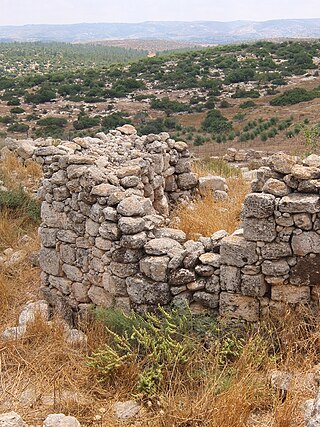
Khirbat Umm Burj was a Palestinian Arab village in the Hebron Subdistrict, sometimes designated in modern maps as Burgin. Its ruins are today located within the borders of Israel. It occupied an extensive site, stretching about 30 dunams on the crest of a hill, rising some 430 metres (1,410 ft) above sea level, and commanding a good prospect of the surrounding region. It was depopulated during the 1948 Arab–Israeli War on October 28, 1948, during the third stage of Operation Yo'av under the command of Yigal Allon. The site is located 17 km northwest of Hebron.
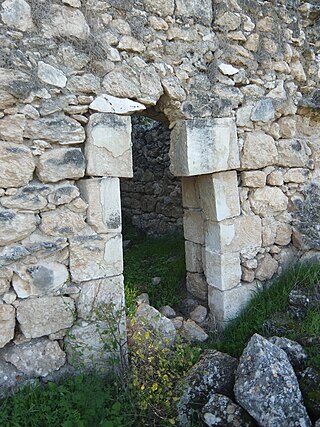
Dayr Aban was a Palestinian Arab village in the Jerusalem Subdistrict, located on the lower slope of a high ridge that formed the western slope of a mountain, to the east of Beit Shemesh. It was formerly bordered by olive trees to the north, east, and west. The valley, Wadi en-Najil, ran north and south on the west-side of the village.
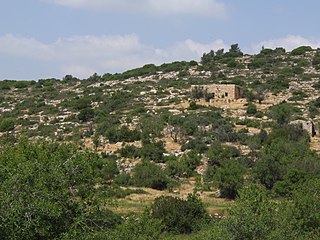
Khirbat al-Tannur, also known as Allar al-Sifla, was a Palestinian Arab hamlet in the Jerusalem Subdistrict, near Allar. It was depopulated during the 1948 Arab–Israeli War on October 21, 1948, under Operation Ha-Har. It was located 18.5 km west of Jerusalem.

Khirbat Zakariyya was a Palestinian village in the Ramle Subdistrict of Mandatory Palestine. It was depopulated during the 1948 Arab–Israeli War on July 12, 1948, under the second stage of Operation Dani. It was located 9 km (5.6 mi) east of Ramla.
Moresheth-Gath, also Moreshet-Gat, was a town of the tribe of Judah in ancient Israel mentioned in the Bible. It was located in the Shephelah region between Lachish and Achzib.

Horvat 'Ethri, or Umm Suweid, is an archaeological site situated in the Judean Lowlands in modern-day Israel. Excavations at the site have uncovered the remains of a partially restored Jewish village from the Second Temple period. The site features an ancient synagogue, wine presses, cisterns, mikvehs, stone ossuaries, and an underground hideout system.

Adullam-France Park, also known as Parc de France-Adoulam, is a sprawling park of 50,000 dunams (ca. 12,350 acres) in the Central District of Israel, located south of Beit Shemesh. The park, established in 2008 for public recreation, features two major hiking and biking trails, and four major archaeological sites from the Second Temple period. It stretches between Naḥal Ha-Elah, its northernmost boundary, to Naḥal Guvrin, its southernmost boundary. To its west lies the Beit Guvrin-Beit Shemesh highway, and to its east the "green line" – now territories under joint Israeli-Palestinian Arab control – which marks its limit.
Khirbet Ibziq, Kh. Ibzîk, the ruin of Ibzîk, p.n. is the name of a village with two ruins in the West Bank, separated by one kilometer and referred to in the Manasseh Hill Country Survey as Khirbet Ibziq and Khirbet Ibziq. They are about twenty kilometers northeast of Nablus. The "Lower" site is to the northeast of the "Upper" site.

Chezib, also known as Achzib of Judah, is a biblical place-name associated with the birth of Judah's son, Shelah (Genesis 38:5), corresponding to the Achzib of the Book of Joshua (15:44), a town located in the low-lying hills of the plain of Judah, known as the Shefela. In I Chronicles 4:22, the town is rendered as Chozeba. The place is now a ruin.

Khirbet et-Tibbâneh (Arabic: خربة التبانة), sometimes referred to by historical geographers as the Timnah of Judah, is a small ruin situated on a high ridge in the Judaean mountains, in the Sansan Nature Reserve, 622 metres (2,041 ft) above sea level, about 3 kilometers east of Aviezer and ca. 7 kilometers southeast of Bayt Nattif.

Lavnin (Hebrew: חורבת לבנין)(Arabic: خربة تل البيضة), is a late Bronze Age archaeological site situated in Israel's Adullam region, rising some 389 metres (1,276 ft) above sea level. The site lies 8 kilometres (5.0 mi) northwest of Beit Gubrin, and about 1 kilometer west-north-west of Khirbat Umm Burj, directly south of Nehusha.

Horvat Maon/Horvat Ma'on, Arabic: Khirbet Ma'in or Tell Máîn, is an archaeological site in the Hebron Hills, West Bank, rising 863 metres (2,831 ft) above sea level, where the remains of the ancient town of Ma'on have been excavated. The town, now a ruin, is mentioned in the Book of Joshua and the Books of Samuel. It still had a Jewish population during the Roman and Byzantine periods, and a synagogue was discovered there. The site was ultimately abandoned around the time of the Muslim conquest.

